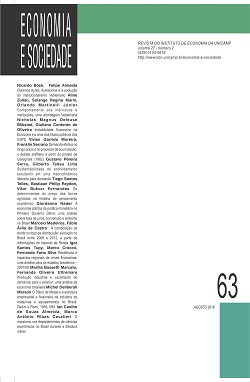Resumo
Este artigo analisa a sustentabilidade do endividamento estudantil em um modelo teórico no qual o nível de atividade econômica é determinado pela demanda efetiva agregada. Enquanto grande parte da literatura sobre dívida estudantil considera em sua avaliação de sustentabilidade apenas os diferenciais de salário entre trabalhadores com níveis de escolaridade distintos, propõe-se uma metodologia formal que compreenda os impactos desse endividamento sobre determinadas variáveis macroeconômicas que influenciam a capacidade de pagamento dessa dívida, tais como a taxa de emprego. São comparadas duas formas de pagamento da dívida, sendo a primeira similar aos Income-Driven Repayment Plans, recentemente comuns nos Estados Unidos, e a segunda a propensão marginal a consumir das famílias que se adapta, em alguma medida, ao serviço da dívida. O resultado obtido indica que fatores como a distribuição da renda e as propensões marginais a consumir de diferentes classes funcionais têm impacto sobre as condições macroeconômicas para a sustentabilidade desse endividamento.
Referências
AKERS, B.; CHINGOS, M. M. Is a student loan crisis on the horizon? Brown Center on Education Policy, Brookings Institution, 2014b.
AVERY, C.; TURNER, S. Student loans: do college students borrow too much-or not enough? Journal of Economic Perspectives, v. 26, n. 1, p. 165-192, 2012.
BARBA, A.; PIVETTI, M. Rising household debt: Its causes and macroeconomic implications–a long-period analysis. Cambridge Journal of Economics, n. 33, n. 1, p. 113-137, 2009.
BECKER, G. S. Human capital: a theoretical and empirical analysis with special reference to education. New York: Columbia University Press, 1964.
BROWN, M. et al. Measuring student debt and its performance. Federal Reserve Bank of New York, 2014. (Staff Reports, n. 668).
CARD, D. The causal effect of education on earnings. In: ASHENFELTER, O. C.; CARD, D. Handbook of labor economics. v. 3, part. A. North-Holland: Elsevier, 1999. p. 1801-1863.
CARNEIRO, P.; HECKMAN, J. J.; VYTLACIL, E. J. Estimating marginal returns to education. The American Economic Review, v. 101, n. 6, p. 2754-2781, 2011.
CHARPE, M.; FLASCHEL, P.; PROAÑO, C. R. Income distribution, credit rationing and households’ debt. Metroeconomica, v. 63, n. 3, p. 458-492, 2012.
COLLEGE BOARD. Trends in college pricing 2015. New York: College Board, 2015.
DUTT, A. K. Stagnation, income distribution and monopoly power. Cambridge Journal of Economics, v. 8, n. 1, 1984.
DUTT, A. K. Growth, distribution and uneven development. Cambridge: Cambridge University Press, 1990.
DUTT, A. K. Consumption, debt and growth. In: SETTERFIELD, M. (Ed.). Interactions in analytical political economy. Armonk, NY: M.E. Sharpe, 2005. p. 155-178.
DUTT, A. K. Maturity, stagnation and debt: a Steindlian approach. Metroeconomica, n. 57, p. 339-364, 2006.
DYNARSKI, S.; KREISMAN, D. Loans for educational opportunity: making borrowing work for today’s students. The Hamilton Project, 2013.
DYNARSKI, S. An economist’s perspective on student loans in the United States. Economic Studies at Brookings, 2014. (ES Working Paper Series).
IES – Institute of Education Science. Digest of education statistics 2014. 50th ed. Washington: National Center for Education Statistics, 2016.
KAPELLER, J.; SCHÜTZ, B. Debt, boom, bust: a theory of Minsky-Veblen cycles. Journal of Post Keynesian Economics, v. 36, n. 4, p. 781-814, 2014.
KAPELLER, J., SCHÜTZ, B. Conspicuous consumption, inequality and debt: the nature of consumption driven profit-led regimes. Metroeconomica, v. 66, n. 1, p. 51-70, 2015.
LIMA, G. T.; MEIRELLES, A. J. A. Macrodynamics of debt regimes, financial instability and growth. Cambridge Journal of Economics, v. 31, n. 4, p. 563-580, 2007.
LOCHER, L.; MONGE-NARANJO, A. Student loans and repayment: theory, evidence and policy. In: HANUSHEK, E. A.; MACHIN, S.; WOESSMAN, L. Handbook of the economics of education, v. 5. North-Holland: Elsevier, 2016. p. 397-478.
MINSKY, H. P. The financial instability hypothesis. The Jerome Levy Economics Institute, 1992. (Working Paper, n. 74).
MINSKY, H. P. Financial factors in the economics of capitalism. Journal of Financial Services Research, v. 9, p. 197-208, 1995.
MINSKY, H. P. (1986) Estabilizando uma economia instável. 2 ed. Trad. de José Maria Alves da Silva. Osasco, SP: Novo Século Editora, 2013.
OREOPOULOS, P.; SALVANES, K. G. Priceless: the nonpecuniary benefits of schooling. Journal of Economic Perspectives, v. 25, n. 1, p. 159-184, 2011.
ROWTHORN, B. Demand, real wages and economic growth. Thames Papers in Political Economy, Autumn, 1981.
SETTERFIELD, M.; KIM, Y. K. Debt servicing, aggregate consumption, and growth. Structural Change and Economic Dynamics, v. 36, p. 22-33, 2016.
SETTERFIELD, M.; KIM, Y. K.; RESS, J. Inequality, debt servicing, and the sustainability of steady state growth. New School for Social Research, Department of Economics, 2014. (Working Paper, 1404).
STEINDL, J. Maturity and stagnation in American capitalism. New York: Monthly Review Press, 1952.
A Economia e Sociedade utiliza a licença do Creative Commons (CC), preservando assim, a integridade dos artigos em ambiente de acesso aberto.


